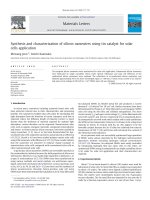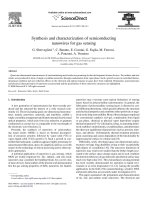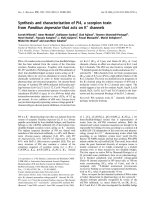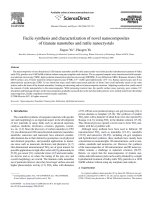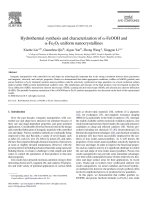- Trang chủ >>
- Khoa Học Tự Nhiên >>
- Vật lý
synthesis and characterization of cdse-zns core-shell quantum dot
Bạn đang xem bản rút gọn của tài liệu. Xem và tải ngay bản đầy đủ của tài liệu tại đây (4.32 MB, 128 trang )
SYNTHESIS AND CHARACTERIZATION OF
CdSe-ZnS CORE-SHELL QUANTUM DOTS FOR
INCREASED QUANTUM YIELD
A Thesis
Presented to
The Faculty of the Department of Materials Engineering
California Polytechnic State University
San Luis Obispo
In Partial Fulfillment of the Requirements of the Degree
Master of Science in Engineering
With Specialization in Materials Engineering
By
Joshua James Angell
July 2011
ii | P a g e
© 2011
Joshua James Angell
ALL RIGHTS RESERVED
iii | P a g e
COMMITTEE MEMBERSHIP
TITLE: SYNTHESIS AND
CHARACTERIZATION OF
CDSE-ZNS CORE-SHELL
QUANTUM DOTS
AUTHOR: Joshua James Angell
DATE SUBMITTED: July, 2011
COMMITTEE CHAIR: Dr. Katherine Chen
COMMITTEE MEMBER: Dr. Richard Savage
COMMITTEE MEMBER: Dr. Lily Laiho
iv | P a g e
ABSTRACT
Synthesis and Characterization of CdSe-ZnS Core-Shell Quantum Dots
for Increased Quantum Yield
Joshua James Angell
Quantum dots are semiconductor nanocrystals that have tunable emission through
changes in their size. Producing bright, efficient quantum dots with stable fluorescence is
important for using them in applications in lighting, photovoltaics, and biological
imaging. This study aimed to optimize the process for coating CdSe quantum dots (which
are colloidally suspended in octadecene) with a ZnS shell through the pyrolysis of
organometallic precursors to increase their fluorescence and stability. This process was
optimized by determining the ZnS shell thickness between 0.53 and 5.47 monolayers and
the Zn:S ratio in the precursor solution between 0.23:1 and 1.6:1 that maximized the
relative photoluminescence quantum yield (PLQY) while maintaining a small size
dispersion and minimizing the shift in the center wavelength (CWL) of the fluorescence
curve. The process that was developed introduced a greater amount of control in the
coating procedure than previously available at Cal Poly.
Quantum yield was observed to increase with increasing shell thickness until 3
monolayers, after which quantum yield decreased and the likelihood of flocculation of
the colloid increased. The quantum yield also increased with increasing Zn:S ratio,
possibly indicating that zinc atoms may substitute for missing cadmium atoms at the
CdSe surface. The full-width at half-maximum (FWHM) of the fluorescence spectrum
did not change more than ±5 nm due to the coating process, indicating that a small size
dispersion was maintained. The center wavelength (CWL) of the fluorescence spectrum
red shifted less than 35 nm on average, with CWL shifts tending to decrease with
v | P a g e
increasing Zn:S ratio and larger CdSe particle size. The highest quantum yield was
achieved by using a Zn:S ratio of 1.37:1 in the precursor solution and a ZnS shell
thickness of approximately 3 monolayers, which had a red shift of less than 30 nm and a
change in FWHM of ±3 nm. Photostability increased with ZnS coating as well. Intense
UV irradiation over 12 hours caused dissolution of CdSe samples, while ZnS coated
samples flocculated but remained fluorescent. Atomic absorption spectroscopy was
investigated as a method for determining the thickness of the ZnS shell, and it was
concluded that improved sample preparation techniques, such as further purification and
complete removal of unreacted precursors, could make this testing method viable for
obtaining quantitative results in conjunction with other methods.
However, the ZnS coating process is subject to variations due to factors that were
not controlled, such as slight variations in temperature, injection speed, and rate and
degree of precursor decomposition, resulting in standard deviations in quantum yield of
up to half of the mean and flocculation of some samples, indicating a need for as much
process control as possible.
Keywords: Quantum dots, semiconductors, lighting, LED, solar, photovoltaic, biological
imaging, CdSe, ZnS, nucleation, growth, pyrolysis, organometallic, fluorescence,
absorbance, spectrophotometer, atomic absorption spectroscopy.
vi | P a g e
ACKNOWLEDGEMENTS
I would first like to thank my advisors, Dr. Kathy Chen and Dr. Richard Savage, for
always being there for me in times of productivity, crisis, and everywhere in between.
I would also like to thank Dr. Lily Laiho for being there throughout my project with
guidance, providing funding for supplies, and serving on my committee.
I want to recognize the chemistry professors, Dr. Phil Costanzo, Dr. Chad Immoos, and
Dr. Corinne Lehr, who went out of their way to help me use their equipment and
understand complex chemistry phenomena.
I would also like to show gratitude towards Boeing and General LED for funding and
encouraging quantum dot research at Cal Poly.
The entire quantum dot group deserves my appreciation as well, especially Sabrina and
Aaron, who helped me build off of their work and gave me guidance even after they left
Cal Poly.
Next, I would like to thank Brian, Patrick, Tim, Adam, Mike, and the rest of the grad
students and the Microsystems Technology Group (MST) for always being there to help
me work out problems, keeping me company in the lab at all hours, and keeping me in
good spirits.
Last but not least, I would like to thank my family, friends, roommates, and Lindsey. I
love you all and appreciate all of the support you have given me throughout the years.
vii | P a g e
TABLE OF CONTENTS
LIST OF FIGURES IX
LIST OF TABLES XIII
LIST OF EQUATIONS XIV
CHAPTER 1 INTRODUCTION 1
1.1 Basics of Quantum Dots 1
1.2 Applications 2
1.1.1 Lighting 2
1.2.1 Solar and Photovoltaics 5
1.2.2 Biological Imaging 6
CHAPTER 2 TECHNICAL BACKGROUND 10
2.1 How do Quantum Dots Work? 10
2.1.1 Semiconductors 10
2.1.2 Quantum Confinement 11
2.1.3 Fluorescence 13
2.2 Quantum Dot Materials 14
2.3 Quantum Dot Synthesis Techniques 16
2.4 Core-Shell Quantum Dots 20
2.4.1 Motivation for Core-Shell Quantum Dots 20
2.4.2 Types of Core-Shell Quantum Dots 21
2.4.3 Choosing a Shell Material for Type-I Systems 22
2.4.4 CdSe-ZnS Core-Shell System 23
CHAPTER 3 PROJECT OVERVIEW 25
3.1 Long Term Goals at Cal Poly 25
3.2 Previous Work at Cal Poly 26
3.3 Problem Description 27
3.3.1 Important Factors 28
3.3.2 Response Variables 28
3.3.3 Experimental Design 30
CHAPTER 4 MATERIALS AND METHODS 33
4.1 Processing Flow 33
4.2 Cadmium Selenide Synthesis 33
4.3 ZnS Coating of CdSe Quantum Dots 37
4.4 Precipitation and Redistribution 43
4.5 Characterization 45
viii | P a g e
CHAPTER 5 RESULTS 48
5.1 Flocculation 48
5.2 Quantum Yield 49
5.3 Full-Width at Half-Maximum 54
5.4 Center Wavelength Shift 56
5.5 Optimization 59
CHAPTER 6 DISCUSSION 64
6.1 Flocculation 64
6.2 Quantum Yield 66
6.3 Full-Width at Half-Maximum 68
6.4 Center Wavelength Shift 68
CHAPTER 7 OBSERVATIONS FROM SECONDARY TESTS 71
7.1 Photostability 71
7.2 TOP instead of TBP for ZnS Precursor Solvent 73
7.3 Atomic Absorption Spectroscopy 74
CHAPTER 8 CONCLUSIONS 79
CHAPTER 9 RECOMMENDATIONS AND FUTURE WORK 81
9.1 ZnS Reaction 81
9.2 Characterization 82
9.3 Applications 83
LIST OF REFERENCES 84
APPENDIX A: “SMALL BATCH” CDSE SYNTHESIS PROCEDURE WITH
SILICONE OIL BATH FOR HEATING 87
APPENDIX B: ZNS COATING PROCEDURE 106
APPENDIX C: DATA FOR QUANTUM YIELD, CENTER WAVELENGTH
SHIFT, AND CHANGE IN FWHM CALCULATIONS 112
ix | P a g e
LIST OF FIGURES
Figure 1: The wavelength of light emitted by quantum dots is tunable by changing
the particle size. In this image, all of the quantum dot samples are excited by the
same UV wavelength, but emit different visible wavelengths depending on
particle size. 1
Figure 2: Efficiency of light produced by incandescent, compact fluorescent, and
LED lamps, expressed in lumens per watt. 2
Figure 3: Schematic of the p-n junction in a light emitting diode (LED). 3
Figure 4: Light spectra of standard LED, quantum dot film LED, and
incandescent bulbs. 4
Figure 5: Comparison of solar spectrum with wavelengths that nanocrystals can
efficiently absorb. 6
Figure 6: Current strategies to create quantum dot based solar cells. (a) metal-QD
junction, (b) polymer-QD junction, (c) QD-dye sensitized solar cells. 6
Figure 7: Absorbance and fluorescence spectra of quantum dots (a-c) in
comparison to organic dyes (d-f). 7
Figure 8: Being able to tune the emission of quantum dots allows a wide variety
of easily distinguishable colors to be used for fluorescence labeling with a single
excitation source. 8
Figure 9: Illustration of a shelled, biofunctionalized quantum dot. 9
Figure 10: Energy barriers to conduction for metals, semiconductors, and
insulators. 10
Figure 11: Energy bands of bulk semiconductors, quantum dots, and molecules. 11
Figure 12: Density of states as a function of dimensions of quantum confinement.
Quantum dots confine the exciton in three dimensions and can be approximated as
zero-dimensional structures. 12
Figure 13: A quantum dot exhibits bandgap tunability because it is smaller than
the spatial separation between the electron and its hole, known as the exciton
Bohr radius. 12
Figure 14: Mechanism of excitation and emission due to radiative recombination
of an electron and hole. 14
Figure 15: Typical absorbance (dashed line) and fluorescence (solid line) spectra
for CdSe QDs. 14
Figure 16: (A) Wurtzite and (B) zincblende crystal structures. 15
Figure 17: Nucleation and growth of nanoparticles in a solution of hot organic
solvents. 18
x | P a g e
Figure 18: Absorbance of quantum dots produced using the CdO/ODE/OA
method, showing tunable reactivity of the precursors through adjustment of the
ligand concentration. 19
Figure 19: Band (valence and conduction bands) alignment of different core-shell
systems. 21
Figure 20: Electronic energy levels of selected III-V and II-VI semiconductors
based valence band offsets (CB = conduction band, VB = valence band). 22
Figure 21: Illustration of CdSe quantum dot before and after coating with ZnS. 23
Figure 22:2nd-order relationship between ZnS shell thickness and quantum yield,
with PLQY maximized between one and two monolayers. 24
Figure 23: Comparison of commercial QDs and QDs synthesized at Cal Poly
showing much greater fluorescence intensity for commercially available quantum
dots than those synthesized at Cal Poly. 27
Figure 24: FWHM and CWL of a Gaussian distribution. 29
Figure 25: Red shift of the fluorescence spectrum due to the ZnS coating process. 29
Figure 26: Levels of a circumscribed central composite design. 31
Figure 27: Graphical representation of the central composite design points used in
this study. 32
Figure 28: Processing paths for QDs synthesized. 33
Figure 29: CdSe synthesis process flow 34
Figure 30: Absorbance spectra from 2 large batches of uncoated CdSe QDs. 36
Figure 31: Effect of time to ramp up to coating temperature on fluorescence
spectra indicating a difference in red shift during the coating process for different
ramp up times (excitation at 480 nm). 38
Figure 32: Pyrolysis of diethyl zinc and hexamethyldisilathiane into zinc and
sulfur ions, which then forms ZnS. 39
Figure 33: Process flow for coating CdSe QDs with ZnS shell. 40
Figure 34: Integral of the fluorescence curve for samples assuming varying
reaction yield in order to form 2 monolayers of ZnS on CdSe quantum dots,
normalized to the same absorbance at the excitation wavelength (385 nm) for all
samples. 42
Figure 35: Schematic of a dual beam spectrophotometer like the Jasco V-550. 45
Figure 36: Schematic of a spectrofluorometer such as the Jasco FP-6500 46
Figure 37: Amplitude-weighted Gaussian function. 47
xi | P a g e
Figure 38: Raw and Gaussian fitted fluorescence spectra. 47
Figure 39: (A) Full suspension (B) Partial precipitation (C) Full precipitation (D-
F) Corresponding fluorescence for A-C. In (F), the color of the supernatant is due
to scattering; only the precipitate is fluorescing. It can be seen that even when
partially or fully precipitated, the quantum dots still fluoresce brightly 48
Figure 40: Full central composite design and combinations for which at least one
sample precipitated. 49
Figure 41: Boxplot of quantum yield vs shell thickness for d= 2.34 nm CdSe
cores. Star indicates precipitation and so no data could be collected. 50
Figure 42: Boxplot of quantum yield vs Zn:S ratio for d= 2.69 nm CdSe cores.
Star indicated precipitation and so no data could be collected. 50
Figure 43: Boxplot of quantum yield vs ratio and thickness for d= 2.34 nm CdSe
cores. Star indicates precipitation and so no data could be collected. 50
Figure 44: Average PLQY vs ratio and thickness for d= 2.34 nm CdSe cores. 51
Figure 45: Boxplot of quantum yield vs shell thickness for d= 2.69 nm CdSe
cores. Star indicates precipitation and so no data could be collected. 52
Figure 46: Boxplot of quantum yield vs Zn:S ratio for d= 2.69 nm CdSe cores.
Star indicates precipitation and so no data could be collected. 52
Figure 47: Boxplot of quantum yield vs ratio and thickness for d= 2.69 nm CdSe
cores. Star indicates precipitation and so no data could be collected. 52
Figure 48: Average PLQY vs ratio and thickness for d= 2.34 nm CdSe cores. 53
Figure 49: Boxplot of quantum yield vs CdSe core diameter. 54
Figure 50: Change in FWHM vs Zn:S ratio and ZnS shell thickness for all of the
samples showed no trends based on either factor. 55
Figure 51: Change in FWHM vs CdSe core size showed no significant difference. 55
Figure 52: Boxplot of CWL shift vs Zn:S ratio and ZnS shell thickness, showing
that a smaller CWL shift was observed for samples with a higher Zn:S ratio, but
that there was no trend with ZnS shell thickness. 56
Figure 53: Average CWL shift vs ratio and thickness. 57
Figure 54: Effect of CdSe core size on CWL shift. 57
Figure 55: Proportion of CWL shift due to heating and ZnS coating process. 58
Figure 56: Graphical representation of the central composite design used for the
initial samples, along with the new points used for optimization. 60
xii | P a g e
Figure 57: PLQY vs Zn:S ratio showing that the maximum quantum yield was
obtained at a Zn:S ratio of 1.37:1 61
Figure 58:PLQY vs Zn:S ratio and ZnS shell thickness, indicating that the
maximum quantum yield was obtained with a Zn:S ratio of 1.37:1. 62
Figure 59: Average PLQY vs ratio and thickness for all d= 2.34 nm samples,
including new samples for optimization. 62
Figure 60: Fluorescence spectra of uncoated d=2.34 nm CdSe quantum dots and
coated quantum dots with the highest quantum yield, showing approximately a 4X
increase in fluorescence intensity, relating to a 9.45X increase in quantum yield. 63
Figure 61: Left: CdSe sample prior to ZnS coating. Right: Optimally coated
CdSe-ZnS core-shell sample. Samples excited by a blacklight. 63
Figure 62: Area between particles is depleted of ligands, causing an attractive
force opposite to the repulsion that stabilizes the colloid. 65
Figure 63: Illustration of Ostwald ripening. 69
Figure 64: CdSe quantum dots in chloroform dissociated after 12 hours of UV
exposure. 72
Figure 65: CdSe-ZnS quantum dots in chloroform flocculated after 12 hours of
UV exposure. 72
Figure 66: Fluorescence of CdSe-ZnS after flocculation (same sample as Figure
57). 73
Figure 67: TOPO precipitates in CdSe-ZnS core-shell sample formed using TOP
instead of TBP in ZnS precursor solution. 74
Figure 68: Schematic of atomic absorption spectrophotometer (AAS). 75
Figure 69: Zn:Cd ratio for increasing theoretical ZnS shell thickness as measured
by AAS 77
xiii | P a g e
LIST OF TABLES
Table I: Important comparisons of the features of organic dyes and quantum dots. 9
Table II: Important parameters of bulk semiconductors commonly used for
quantum dots. 15
Table III: Available synthesis methods for producing II-VI semiconductor
quantum dots. 20
Table IV: Levels of variables for ZnS coating CCD experimental design. 32
Table V: Masses and volumes of reactants and solvents in two large batch CdSe
syntheses. 35
Table VI: Conditions for preparation of precursors and two large batch CdSe
syntheses. 35
Table VII: Measured values for CdSe syntheses 37
Table VIII: Moles of precursors and volume of solvent in precursor solutions 43
Table IX: Center wavelength shift due to heating and ZnS coating 58
Table X: Four ZnS coatings performed with the same combination of factors,
showing the large variation in responses due to variations in processing 63
Table XI: Absorbance of cadmium and zinc stock solutions 75
Table XII: Concentrations of cadmium and zinc in quantum dot samples analyzed
by AAS. All samples began with the same CdSe core size (2.3 nm), but grew
during the coating process. Diameters listed were determined from absorbance
spectra. 76
xiv | P a g e
LIST OF EQUATIONS
Equation 1: Change in bandgap due to quantum confinement in a spherical
nanoparticle. 13
Equation 2: CdSe particle diameter as a function of the first excitonic absorbance
peak. 36
Equation 3: Beer-Lambert Law 36
Equation 4: Exctinction coefficient as a function of CdSe particle diameter. 36
Equation 5: Volume of X monolayers of ZnS on a CdSe core of radius r. 41
Equation 6: Number of ZnS monomers in X monolayers. 41
Equation 7: Moles of ZnS needed to coat N
CdSe
moles of CdSe quantum dots with
X monolayers. 41
Equation 8: Quantum yield compared to a reference dye. 46
Equation 9: Amplitude-weighted Gaussian function. 47
Equation 10: Particle growth due to Ostwald ripening 69
1 | P a g e
CHAPTER 1 INTRODUCTION
1.1 Basics of Quantum Dots
Quantum dots are very small crystals of semiconductor materials. Their size
ranges from about a hundred to a few thousand atoms. The diameter of a quantum dot is
approximately between two and ten nanometers, which puts them in a special size range
that retains some properties of bulk materials, as well as some properties of individual
atoms and molecules. As semiconductors, quantum dots have certain associated
electronic and optical properties. For bulk semiconductors, the bandgap of the material is
a set energy barrier between the valence and conduction bands, dictated by the
composition of the material. Unlike bulk semiconductors, the bandgap of a quantum dot
is also influenced by its size. Small quantum dots emit higher energy light than larger
quantum dots, which makes the wavelength of light emitted by the particles tunable, with
smaller particles emitting blue light and larger particles emitting red light (Figure 1).
Figure 1: The wavelength of light emitted by quantum dots is tunable by changing the particle size.
In this image, all of the quantum dot samples are excited by the same UV wavelength, but emit
different visible wavelengths depending on particle size.
1
2 | P a g e
1.2 Applications
Quantum dots find use in many applications that need strong, stable fluorescence
with tunable emission. The primary applications of quantum dots are in energy efficient
lighting, photovoltaics, and biological imaging.
1.1.1 Lighting
Lighting accounts for up to 25% of energy usage in the United States, so
introducing more energy efficient lighting is of key importance.
2
Lighting has progressed
from black body radiators, such as incandescent lamps, to fluorescent lamps to more
efficient forms of lighting such as light emitting diodes (LEDs) (Figure 2). Throughout
this transition, though, it has become very important to retain or improve the quality of
light produced.
Figure 2: Efficiency of light produced by incandescent, compact fluorescent, and LED lamps,
expressed in lumens per watt.
2
Quantum dots are used in lighting either in conjunction with inorganic
semiconductor light emitting diodes (LEDs), such as GaAs or InGaN, or as a replacement
for, or complement to, conductive polymer junctions in thin film LEDs, such as organic
LEDs.
3
Inorganic LEDs are made from direct band-gap semiconductor materials,
typically either III-V or II-VI semiconductors, grown in epitaxial layers on lattice
3 | P a g e
matching substrates. The heart of an inorganic light emitting diode is the p-n junction,
forming a diode. The p-n junction is formed by doping the semiconductor material with
an excess of either positive or negative charge carriers. An n-type semiconductor has an
excess of electrons, while a p-type semiconductor has an excess of holes, or absence of
electrons. When a forward bias is applied to the junction with a voltage that meets or
exceeds the bandgap, electrons and holes recombine, creating light (Figure 3). It is the
need for radiative recombination that necessitates using a direct bandgap semiconductor
material. Semiconductors with indirect bandgaps, such as silicon and germanium, cannot
be used for LEDs because the recombination of holes and electrons is nonradiative,
dissipating energy as heat and lattice vibrations instead of light.
Figure 3: Schematic of the p-n junction in a light emitting diode (LED).
The bandgap of a semiconductor is tied primarily to its composition, which means
that the wavelength of light that an LED emits is inversely proportional to the energy of
the bandgap. For example, wide bandgap LEDs produce ultraviolet (UV) or blue light,
while small bandgap LEDs produce red or infrared light. For this reason, it is difficult to
significantly manipulate the color of a LED using only the diode itself. Due to the tunable
4 | P a g e
emission and broad excitation of quantum dots, their use in conjunction with LEDs is
very promising to produce energy efficient lighting with tunable emission.
Typically to produce white light from LEDs, a blue or ultraviolet LED is used in
conjunction with a yellow phosphor, such as Ce:YAG.
3
Due to the inefficiencies of
phosphors in converting light, the color spectrum of white LEDs made with phosphors
tends to be concentrated in the blue region, with less intensity in the yellow and red
regions. Replacing the phosphors with quantum dots allows for tuning the color spectrum
that creates white light, making it warmer and more pleasing to the eye (Figure 4). The
color rendering index (CRI), a measure of the accuracy of a light source of reproducing
the solar spectrum, of LED backlit liquid crystal displays (LCDs) can be increased using
quantum dot modified LEDs to produce LCDs that display “truer” colors.
Figure 4: Light spectra of standard LED, quantum dot film LED, and incandescent bulbs.
2
Quantum dots can also be incorporated into organic LEDs.
4
Organic LEDs are
formed by creating a heterojunction between two conducting polymers, resulting in a
difference in work function. When a voltage is applied to this junction, light is emitted in
a similar manner as in inorganic semiconductors. By using polymers, light emitters can
5 | P a g e
be printed on flexible substrates. Quantum dots demonstrate electroluminescence in
addition to photoluminescence, which means that when a voltage is applied to quantum
dots, they will emit light in a similar manner as LEDs.
3
Since quantum dots can be
suspended in solutions, it is also possible to coat them onto flexible substrates in thin
films. Creating thin films of quantum dots to form quantum dot LEDs (QLEDs) allows
their tunability to be used to make thin film LEDs of all colors.
1.2.1 Solar and Photovoltaics
Since quantum dots absorb all wavelengths higher in energy than their bandgap
and convert them to a single color, they can be used to increase the range of wavelengths
absorbed by photovoltaics, increasing their efficiency (Figure 5). There are a couple of
different approaches to use this capability (Figure 6).
5, 16
Organic photovoltaics (OPVs) are a growing industry in the same way as OLEDs
for many of the same reasons. OPVs function in a very similar fashion as OLEDs. As in
QLEDs, quantum dots can be substituted for or used in conjunction with organic
molecules in thin film, printable solar cells. Another method for using quantum dots to
harvest solar energy uses quantum dots for dye-sensitization with TiO
2
nanoparticles.
6 | P a g e
Figure 5: Comparison of solar spectrum with wavelengths that nanocrystals can efficiently absorb.
6
Figure 6: Current strategies to create quantum dot based solar cells. (a) metal-QD junction, (b)
polymer-QD junction, (c) QD-dye sensitized solar cells.
5
1.2.2 Biological Imaging
One of the primary areas of research and commercialization of quantum dots is in
biological imaging. Quantum dots are approximately the same size as a protein, thus
allowing them to enter cells in a similar manner.
7
Most fluorescent dyes are based on
organic molecules, often xanthenes such as rhodamine and fluorescein. There are a
couple of key issues with organic dyes that can be remediated with quantum dots. The
absorbance and fluorescence of organic dyes are tied to their molecular structure,
7 | P a g e
requiring excitation and detection at specific wavelengths. Unlike organic fluorophores,
quantum dots absorb a broad spectrum and emit symmetric, narrow spectra (Figure 7).
7
Figure 7: Absorbance and fluorescence spectra of quantum dots (a-c) in comparison to organic dyes
(d-f).
7
This feature of quantum dots give them advantages over organic fluorophores
because the excitation wavelength can be anywhere within a broad range, making it
easier to avoid excitation of background tissues, as well as simple separation of excitation
and emission (Figure 8).
8 | P a g e
Figure 8: Being able to tune the emission of quantum dots allows a wide variety of easily
distinguishable colors to be used for fluorescence labeling with a single excitation source.
1
In addition to wavelength dependence of excitation, organic fluorophores tend to
degrade with time during excitation, referred to as photobleaching. Quantum dots do not
significantly photobleach, sometimes even exhibiting photobrightening, with excitation
for extended periods of time, allowing for long term imaging.
7
In order to use quantum dots for biological imaging though, some other
considerations must be made that limit their functionality. First, most quantum dots are
based on heavy metal chalcogenide compounds, such as CdSe and CdTe, which can leach
heavy metals into the tissue. To remediate this problem, a non-heavy metal shell, such as
ZnS, is used as a barrier. Second, most quantum dots are only stable in organic solvents
as prepared. To remediate this problem, quantum dots are usually encapsulated in a
polymer shell or a micelle to make them soluble in aqueous solvents. Biotags can then be
attached to the polymer. However, after all of the coatings and functionalization, the
hydrodynamic diameter of a quantum dot can often be much larger than its core diameter,
limiting the effectiveness of having such a small particle (Figure 9).
7
9 | P a g e
Figure 9: Illustration of a shelled, biofunctionalized quantum dot.
1
Still, quantum dots show great promise in biological imaging, especially in
applications where robust, bright and stable fluorophores are needed. Table I summarizes
many of the advantages and disadvantages of quantum dots compared to traditional
organic dyes.
Table I: Important comparisons of the features of organic dyes and quantum dots.
7
Organic Dye
Quantum Dot
Absorption spectra
Discrete bands
FWHM 35 to 100 nm
Broad with steady increase
toward UV wavelengths
Molar absorption coefficient
10
4
to 10
5
10
5
to 10
6
Emission spectra
Assymetric
FWHM 35 to100 nm
Symmetric Gaussian
FWHM 30 to 90 nm
Quantum yield
50% to 100%
10% to 80%
Fluorescence lifetime
1 to 10 ns
10 to 100 ns
Binding
Via functional groups following
established protocols
Often several dyes bind to a
single biomolecule
Via ligand chemistry; few
protocols available
Several biomolecules bind
to a single quantum dot
Size
~0.5 nm; small molecule
6 to 60 nm (hydrodynamic
diameter); colloid
Photochemical stability
Sufficient for most applications
Can be insufficient for high-
light flux and long term
imaging
High
Orders of magnitude higher
than organic dyes
Possible photobrightening
Toxicity
Very low to high, depending
on molecule
Little known yet
Must prevent heavy metal
leakage
Potential nanotoxicity
Reproducibility
Good, owing to defined
molecular structure and
established characterization
Limited by complex
structure and surface
chemistry
Limited data available
10 | P a g e
CHAPTER 2 TECHNICAL BACKGROUND
2.1 How do Quantum Dots Work?
2.1.1 Semiconductors
To understand quantum dots, we must first understand the materials that compose
them. Semiconductors are a class of materials defined primarily by their electronic
properties. In metals and other conductors, the conduction and valence bands overlap,
without a significant energy barrier for promoting electrons from the valence to the
conduction band. In insulators, there is a large energy barrier for promoting electrons
from the valence to the conduction band, essentially eliminating conduction. In
semiconductors, however, the energy barrier for conduction is intermediate between
conductors and insulators (Figure 10). Typically, the bandgaps (E
g
) for metals,
semiconductors, and insulators are less than 0.1 eV, between 0.5 and 3.5 eV, and greater
than 4 eV, respectively.
7
Figure 10: Energy barriers to conduction for metals, semiconductors, and insulators.
11 | P a g e
2.1.2 Quantum Confinement
Quantum dots have a tunable bandgap due to a concept called quantum
confinement. To understand quantum confinement, we need to look at how energy bands
work in atoms and work our way up to the bulk scale. Atoms have degenerate, discrete
energies at which electrons can reside, allowing more than one electron to reside in a
single energy level. When atoms are brought together, their electron clouds start to
interact and the degenerate states split into different energy levels. Once the number of
atoms interacting reaches the bulk level, the states are split into so many energy levels
that the states can be considered continuous because the spacing between energy levels is
infinitesimally small (Figure 11).
8
Figure 11: Energy bands of bulk semiconductors, quantum dots, and molecules.
As the excitons are confined to a space smaller than the exciton Bohr radius, or the
spatial separation between the electron and the hole left behind when it jumps the
bandgap, less states become available. This continues until excitons are confined in all
three dimensions, at which point the energy levels become discrete (Figure 12).
![Tài liệu Báo cáo khoa học: Specific targeting of a DNA-alkylating reagent to mitochondria Synthesis and characterization of [4-((11aS)-7-methoxy-1,2,3,11a-tetrahydro-5H-pyrrolo[2,1-c][1,4]benzodiazepin-5-on-8-oxy)butyl]-triphenylphosphonium iodide doc](https://media.store123doc.com/images/document/14/br/vp/medium_vpv1392870032.jpg)

